

Java Development: Code Obfuscation and Decompilation Protection Practice
Introduction:
In Java development, code security is an important consideration. In order to prevent others from stealing, modifying or copying your code through decompilation, code obfuscation and decompilation protection are essential means. This article will introduce some commonly used code obfuscation and decompilation protection techniques, and give specific code examples.
1.2 Modification of code logic:
By changing the logical structure of the code, the complexity of the code is increased, making it difficult to understand. For example, change the conditional statement if (i > 0 && j
1.3 Insertion of useless code:
Insert some meaningless statements into the code to increase the size of the code and make it difficult for the decompiler to analyze the real purpose of the code. For example, insert the System.out.println("Hello World!") statement.
The following is a sample code that demonstrates how to obfuscate variable names and class names:
public class CodeObfuscationExample { public static void main(String[] args) { String a123b = "Hello World!"; int x = 10; int y = 5; int z = x + y; System.out.println(a123b); System.out.println(z); } }
2.2 String splicing:
Splice the various parts of the string, making it difficult for the decompiled code to directly obtain the complete string content. For example, concatenate the strings "Hello" and "World!" into "helloworld".
2.3 Using JNI (Java Native Interface):
By using JNI technology, the key parts of the code are implemented in local code, so that the decompiled code cannot directly obtain the key logic. JNI needs to be written in languages such as C/C.
The following is a sample code that demonstrates how to encrypt a string to protect the code:
public class StringEncryptExample { private static final String ENCRYPTED_STRING = "SGVsbG8gV29ybGQh"; // 加密后的字符串 public static void main(String[] args) { String decryptedString = decryptString(ENCRYPTED_STRING); System.out.println(decryptedString); } private static String decryptString(String encryptedString) { byte[] decodedBytes = Base64.getDecoder().decode(encryptedString); return new String(decodedBytes); } }
Conclusion:
Code obfuscation and decompilation protection technology are effective means to protect Java code security. Through code obfuscation and decompilation protection technology, the readability, understanding difficulty and decompilation complexity of the code can be increased, thereby improving the security of the code. In actual projects, for code involving sensitive information or commercial secrets, we should make full use of these technologies to protect the security of our code.
The above is the detailed content of Java Development: How to Obtain Code Obfuscation and Decompilation Protection. For more information, please follow other related articles on the PHP Chinese website!




